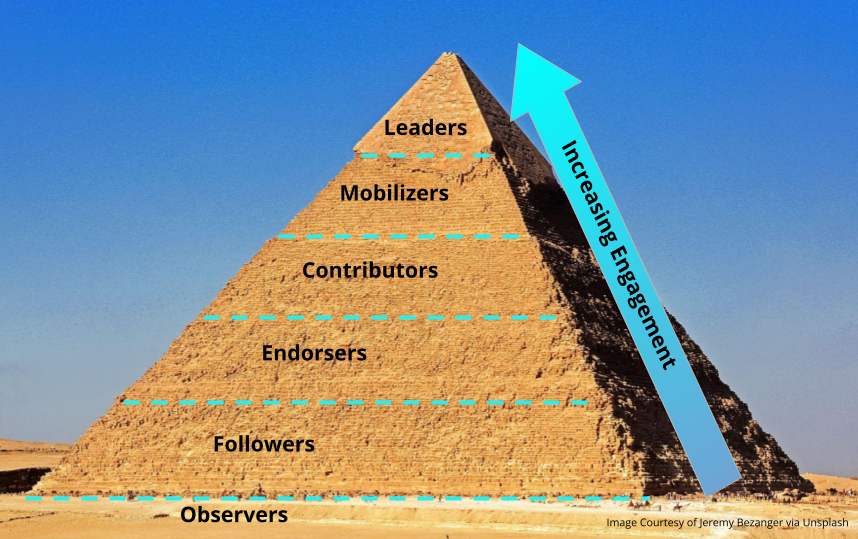Credit where credit is due: thank you to Beth Saunders for introducing us to the concept of the Engagement Pyramid, and to Groundwire for the framework.
Why Should We Measure Engagement?
We know instinctively that some actions demonstrate a higher level of engagement than others: signing up for emails does not demonstrate the same level of investment in a cause as donating or volunteering. The challenge comes when trying to understand, at scale, what an appropriate next step to offer someone is and which offerings are most effective at maintaining and increasing engagement.
A strong engagement strategy provides value across the organization, from goal-setting to strategic alignment. At Pedal Lucid, we focus on how to quantify engagement in a way that improves communication (right message to the right people) and illuminates efficacy (what initiatives are working well—driving engagement—and which aren’t) through CRM data and analytics tools. In order to do this effectively and at scale, it’s critical to use a systematic approach.
Although the pyramid shares some similarities with a sales funnel—high volume/low engagement progressing to low volume/high engagement; movement between stages or levels serving as a metric of success—these models are fundamentally different. A sales funnel is focused on a singular goal: funneling as many people as possible to closed/won business sale. The engagement pyramid, on the other hand, captures the fact that low-level engagement with a nonprofit or advocacy organization has real value in the way that upper levels of a sales funnel do not. Each model is useful in its own way and they are not mutually exclusive—they just need to be applied in the appropriate context.
The Pyramid Framework
An ‘engagement pyramid’ is a model for engagement that allows an organization to better understand engagement in a holistic way across departments, and in a way that’s measurable, actionable, and scalable. It divides different actions up across a series of levels, from low to high engagement, and assigns levels to a person based on the highest level of action taken within a certain span of time.
The levels outlined below are drawn from Groundwire’s work, although we think it’s fine to modify them to best suit an organization’s needs.

KEY CONCEPTS
- The ‘base’ of the pyramid is composed of many people who engage at a low level. As you move up through the pyramid, levels are made up of progressively fewer people who engage at a deeper level—all the way up to the leaders or champions of your organization.
- Levels are defined based on the actions that someone has taken and are not qualitative. Each way in which someone might interact with your organization can be assigned a particular level, and in order to move from one level to the next a person must engage in a way that maps to that particular level.
- The pyramid is multi-dimensional, and moving levels does not need to be a linear path. Financial contributions are one ‘face’ of the pyramid, but other faces might include volunteering with your programs or advocacy work. Recognizing that different people prefer to engage in different ways is a critical component of building the pyramid.
- Levels are dynamic, and understanding how and why people move between different levels (or continue to engage at one particular level) is crucial information. These are captured in specific data points such as a person’s previous level and the action responsible for the last level movement.
Levels, From the Bottom Up
OBSERVERS
…are familiar with your organization but have not provided contact information. Think website visitors or people who are aware of the work you do but have not connected directly. Note that observers are a key concept to include in a wider engagement strategy, but are—essentially by definition—not in your CRM and thus may be excluded from the type of engagement reporting we can use for other levels of the pyramid.
FOLLOWERS
…have explicitly connected with your organization, for example by signing up for an email list or following on social media. They are interested in your work and would like to stay in the loop but are not actively supporting or participating.
ENDORSERS
…engage in a simple, low-effort and transactional way. Think of occasional low-level donations or signing a petition. They support your work in a tangible way, but in a way that does not require much effort or commitment.
CONTRIBUTORS
...have taken more substantive action, such as committing to a recurring donation or through volunteering their time. They are actively engaged in your work and have started to build a more personal relationship with your organization.
MOBILIZERS
…have started to take ownership of your cause and encourage others to do the same. This group might start an unsolicited peer-to-peer fundraiser or take the initiative to organize volunteer efforts.
LEADERS
…are champions of your cause and deeply committed to your organization. This level is the one in which qualitative assessment might be used over a quantitative definition, in part because the group is small and actions are unique so building an automated system to identify leaders might not be a particularly useful exercise.
The Benefits are Both Operational and Strategic
The way in which you define levels and/or the specific actions associated with each level may vary from one organization to another, but the insights and operational improvements that become possible with this framework are shared.
- Ability to segment by engagement for improved communication. This often happens within the development department for fundraising (major donors receive different and/or more personalized communication vs low-level donors), but the pyramid opens up this type of approach across the entire organization. Another example in which segmentation can be useful is through identifying and connecting with constituents who have previously engaged at a certain level, but not recently. You can apply a similar ‘lapsed’ designation to engagement as a whole that is often used to encourage membership renewals, and reach out to proactively encourage folks with ‘expiring’ levels of engagement to take additional action.
- Quantifying movement between levels to understand what initiatives and actions are most effective. This kind of analysis has a lot in common with marketing and sales attribution, but can be applied in all sorts of interesting ways. Which organizational offerings are people most likely to take advantage of? Are these offerings primarily re-upping involvement from folks who are already engaging at a certain level, or are they effective at moving other people up to higher levels? If you’re interested in digging more deeply into these kinds of questions you might also find some of our articles about ‘source’ to be useful (see Lead Source Part 1 and Part 2).
- The insights have the potential to inform program design. They can help identify gaps in programming based on opportunities to engage at a certain level. Perhaps you have a very strong middle of the pyramid with lots of fairly engaged constituents, but realize that your base is very small. What could you offer at a lower threshold of involvement that might resonate with a larger audience and grow into further involvement down the road? On the other hand, you might realize that you have many low-level followers and endorsers but not enough opportunities for people to take the next step and engage at the contributor level.
Getting Started
This work isn’t easy—it can be challenging enough to map out what you’d like to see, let alone get that vision into an actionable tool in your CRM. The good news is that this concept can provide value for an organization regardless of how tightly integrated it is with your technology.
First, we believe it's most beneficial when different types of engagement share the same framework, but it’s possible to roll this concept out to a single team or department (one face of the pyramid). An example of when this approach might be necessary is when a programs team would like to start using engagement levels, but the development team has deeply ingrained fundraising levels that do not align with this model. We strongly recommend cross-department buy-in when first defining the levels, but if the alternative is no quantifiable metrics we think a partial rollout is fine.
Second, it doesn’t need to be integrated to be useful. While we believe in the value of using hard numbers to look objectively at what the data say compared to our assumptions, a mental model or manual audit (put it together on a spreadsheet!) can help get us thinking about engagement in a more critical way even if ongoing measurement comes later.
Finally, integration comes in various flavors. A complete and fully automated model that lives within your CRM is the most robust approach to leverage data for communications. On the other hand, a reporting-centric approach using something like Tableau or CRM Analytics reduces the reliance on your CRM and may be able to provide even more flexible insights, at the expense of marketing automation. In addition, either approach can be built in a more or less sophisticated way.





